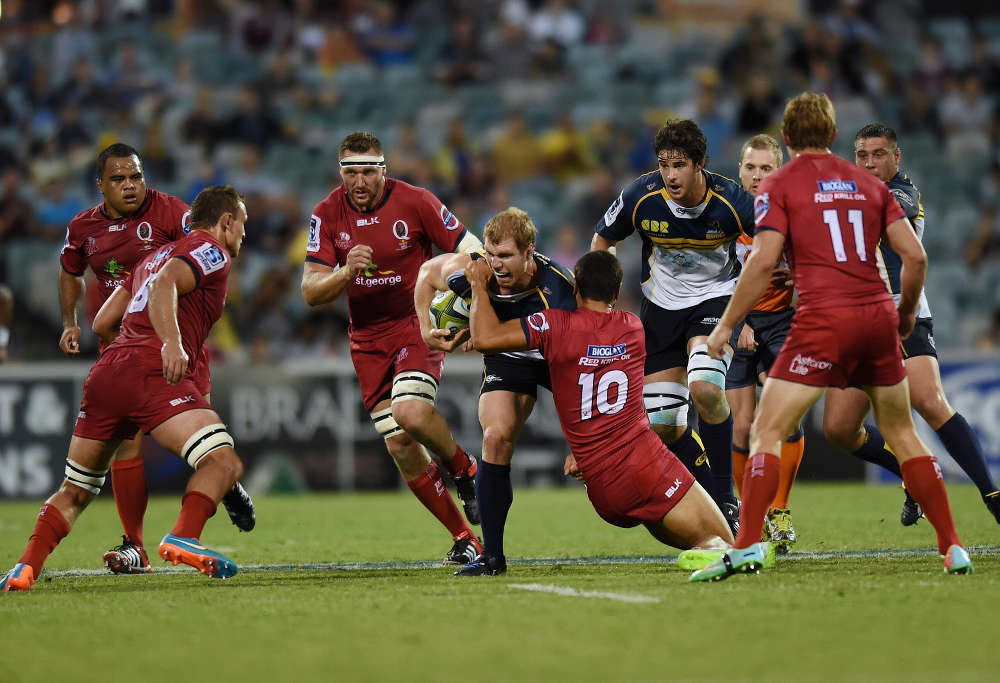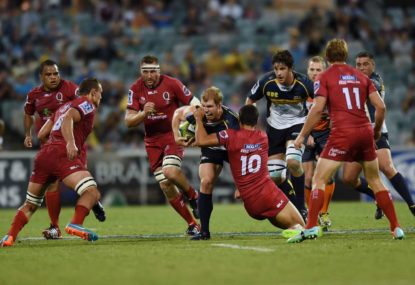Australian rugby hasn’t got enough stars and there’s not many young ones coming through.
This isn’t to say rugby is about to keel over and die, but having viable stars to communicate the game’s skills, excitement and values to the wider public is absolutely critical to its ongoing success.
In particular, the lack of form, poor play and injuries at the Queensland Reds has hurt Australian rugby’s star power. But the other Super Rugby franchises aren’t exactly making up for a down cycle up north.
Star players aren’t easily defined. People often allude to an x-factor and leave it at that when determining what makes a star. I believe it’s a bit more obvious than that: to be a star a player has a noticeable level of talent and charisma to match it. The reason the definition becomes muddy is the final determination – is there enough talent, are they really charismatic? – is in the eye of the beholder.
2015 Super Rugby table
Which goes to saying this may prove an exercise in futility if people have wildly differing views of rugby stardom than my own, but I think you’ll come round.
Firstly, Israel Folau is the star of Australian rugby. He has been since before he played a game for the Waratahs and that has only been confirmed since then. His level of talent (although this year he’s a bit quieter as the team he plays in performs a notch below last year’s highs) alone is enough but he’s also an extremely well known quantity with a humble persona that makes him attractive to kids, parents and sponsors. Put him off to one side.
Back to the Reds: repeated injuries to Quade Cooper means his stardom is more like a red dwarf than his previous supernova status. James O’Connor’s off-field transgressions, time overseas and out of the Reds’ side with injury all compound to take significant lustre away from his obvious talent – you can actually see the difference in his face. Will Genia is currently the Reds’ most viable star but he is on the way back to his peak still after two years well below it and is about to disappear overseas.
Samu Kerevi might be the best bet for a future Reds broad-appeal star at this point based on bankable talent, but the public doesn’t know him yet. And, as a warning, Chris Feauai-Sautia was given similar wraps not long ago.
Julian Savea was interviewed right after the Hurricanes victory against the Reds on Sunday evening. He is probably a bigger star to Australian rugby tragics than any Reds player right now, but in the eyes of the casual fans he can’t be. There’s no way the opposition wing should be the focal point of the Fox Sports post-game wrap – if there’s a viable star to replace him.

David Pocock is tackled by Karmichael Hunt. (AAP Image/Lukas Coch)
The key here is Karmichael Hunt.
He is a prodigious talent, and was supposed to be the Reds’ star; therefore one of the key stars in the Australian constellation by default. The likes of Genia, the last vapours of James Horwill, the rising Kerevi and Liam Gill would make good neutron stars to Hunt’s supernova.
Hunt was elevated quickly into the leadership group, he was given first shot at Quade Cooper’s number 10 jersey and the media introduced him to the public by the shovel-load. That obviously all came crashing down when the cocaine charges showed up – the black hole – and injury curtailed the rest.
Lest people think I’m just piling on the poor reds, down at the Waratahs, besides Folau, this year the situation isn’t exactly white hot either.
The form, contractual status and future health of Bernard Foley recently filled the media coverage of rugby in Sydney for a couple of weeks straight. I’d say that is because of the absence of other material rather than Foley’s particular stardom. Foley is a fine player, but he isn’t a star at this point. He strikes me more as a strong professional; having made the most of his talents on the field he’ll make the most of them financially and be a dependable asset for any coach for years. But he doesn’t have much to say, won’t rock the boat, or set the world alight.
You need much more than Folau to compete in the Sydney market. Kurtley Beale has been quiet this year and so has rugby in Sydney outside the rugby bubble.
Will Skelton is a solid red giant, but hasn’t quite become a broad appeal star. Adam Ashley Cooper is one identifiable star at the Waratahs, having played well in Canberra and the Wallabies as well. However, like Genia, he’s about to book a well-deserved one-way ticket to Europe.
It’s really quite remarkable actually, the way the Waratahs winning Super Rugby hasn’t translated into more stars, better exposure of players and broader appeal. I don’t know whether there are restrictions on the players being exposed through the media but this year – especially since they brought the same gang back – is definitely the year to let us get to know them more.
If Foley is, indeed, to become a star we need to get to know him. Will Skelton has to be more than just a big body. Jacques Potgeiter has to be more than just a mad man.
Key, flashy, identifiable players at key positions have eluded the Force since Matt Giteau, David Pocock and James O’Connor left. Half back, fly-half and fullback are key positions that are prominently involved, communicating the skill of rugby to the audience, and need to be filled by stable week-to-week performers to help the Force break a star into the mainstream.
Melbourne has a similar problem since James O’Connor, Kurtley Beale and, earlier, Danny Cipriani left. All had various combinations of the talent-charisma formula, but all had enough of each to communicate rugby to the masses.
Canberra is one place where I think stardom is on the rise, instead of decline. Mostly because of one man, David Pocock. I often joke on twitter about Pocock being Prime Minster in a few decades. He probably won’t be – very few people are – but he has the charisma, although different to other sportspeople. And his return to the field and form in another key high-visibility position translates him to a broader audience. Anyone watching can follow his head gear and spot the number seven in a every ruck. However we shouldn’t continue to wait for misguided attacks from News Corp columnists to boost his profile.
The next question for me is, after the World Cup when many senior players leave and possibly even retire, who are the next crop of stars? There’s a big vacuum to fill.






























































































